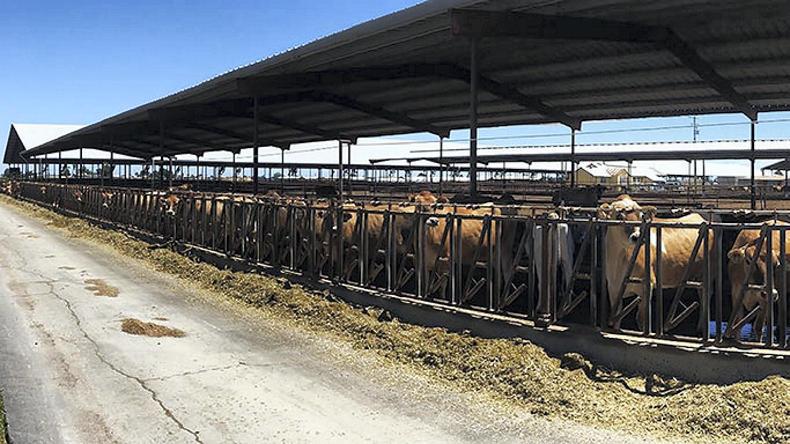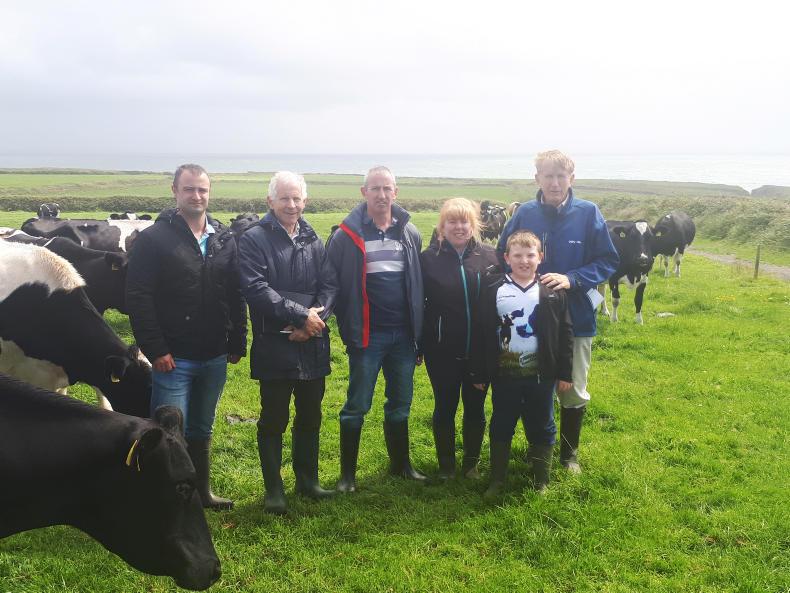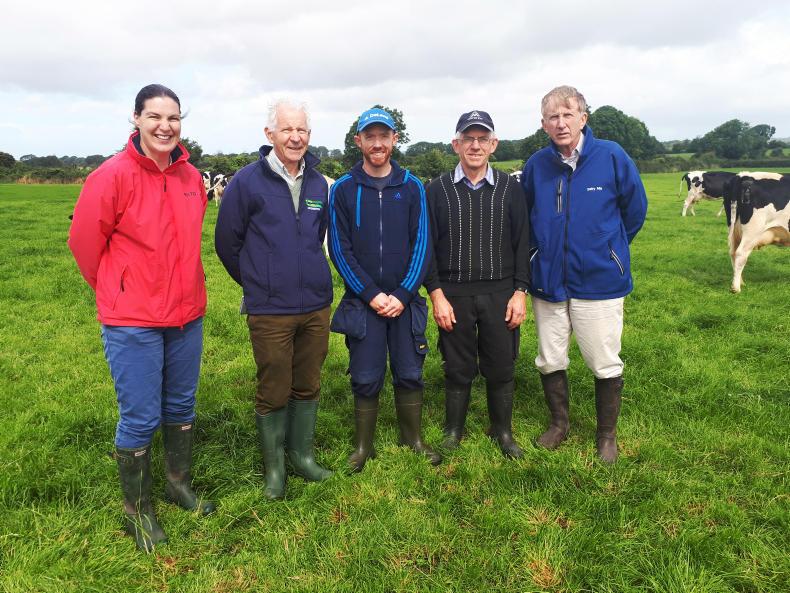My name is Eamon Sheehan from Cuffesgrange, Co Kilkenny, and I was awarded a 2017 Nuffield Scholarship to study Blanket Antibiotic Treatment in Livestock and its Link with Antibiotic Resistance in Humans.
Recently, I travelled to the US as part of my study tour. While there, we had a tour of Clauss Dairy Farms in Hilmar and a visit to Hilmar Cheese visitor centre.
Clauss Dairy Farms
We set off the next morning like teenagers on the way to the ploughing match.
Andrew Plumbski gave up his Sunday downtime to give us an insight into the running of a large-scale dairy herd.
Andrew had previously completed a dairy internship with Hilmar Cheese before starting to work with Clauss farms three years ago as the assistant herd manager.
Clauss Dairy Farm originated in the early 1950s.
Quickly realising the high fat content of the Jersey cow was perfect for cheese making, they built up their herd to a 2,000 pedigree-registered herd supplying Hilmar Cheese.
They also have a second 1,250-cow farm and a daughter milking a 1,900-cow herd next door.

The farm we visited had a 50-stall rotary installed in 2008 capable of milking 350 cows/hour. This ran for 20 hours per day, milking cows three times daily.
There were three milkers per 10-hour shift, one wiping and stripping, one cupping and one checking that cows were milked out properly and controlling cow flow. Cows were in excellent condition and cleanliness was incredible.
They were brought to and from the sheds in groups of 200 to 250, with a turnaround time of about 45 minutes per group.

Herd health
Herd health was a priority for this farm and it could be seen in the cows. They were producing 69lb (30.5kg) of milk per day at 4.7% butterfat and 4.0% protein on average at a 115 SCC.
Any cow that has health issues such as lameness or mastitis is segregated into a hospital group.
Cows were individually charm-tested coming away from this group regardless of withdrawal dates.
Breeding
All breeding was 100% AI.
The top two-thirds of cows received sexed semen for two rounds and then conventional semen and the bottom one-third received beef semen like wagyu.
Heifers were bred at 11 months receiving two rounds of sexed semen and then conventional semen and were calving down at 20 months. Along with this, 50% of the herd were gnomically tested.

All the feeding of the herd was carried out by two diet feeders doing 10-hour shifts. These were used to feed both farms.
Corn silage, wheat silage, alfalfa, rape and corn gluten made up the diet, along with minerals that they mixed in-house with a very impressive computerised system.
Calves
The most labour-intensive part of the farm seemed to be the calves.
At any one time, 600 calves in individual huts received three feeds a day at eight-hour intervals through individual 2l bottles.
All milk was pasteurised for the calves including colostrum in an impressive calf kitchen. All bottles were brought here between feeds to be washed and refilled each time.

Although this was very intensive, it was obviously effective as can be seen with heifers meeting targets and looking incredible as 20-month-old first-calvers. I think they would have cringed if I told them I went to OAD feeding after three weeks of age.
All-in-all this was an incredible experience and the best dairy farm we have seen on our travels.
We will have further updates from Eamon and you can follow his Nuffield travels by following him on Twitter @eamon_sheehan.
Applications for the 2018 Nuffield Scholarship close on 31 July. Anyone interested in applying can visit here.
Read more
Watch: milking 660 cows with a mobile parlour in Chile
My name is Eamon Sheehan from Cuffesgrange, Co Kilkenny, and I was awarded a 2017 Nuffield Scholarship to study Blanket Antibiotic Treatment in Livestock and its Link with Antibiotic Resistance in Humans.
Recently, I travelled to the US as part of my study tour. While there, we had a tour of Clauss Dairy Farms in Hilmar and a visit to Hilmar Cheese visitor centre.
Clauss Dairy Farms
We set off the next morning like teenagers on the way to the ploughing match.
Andrew Plumbski gave up his Sunday downtime to give us an insight into the running of a large-scale dairy herd.
Andrew had previously completed a dairy internship with Hilmar Cheese before starting to work with Clauss farms three years ago as the assistant herd manager.
Clauss Dairy Farm originated in the early 1950s.
Quickly realising the high fat content of the Jersey cow was perfect for cheese making, they built up their herd to a 2,000 pedigree-registered herd supplying Hilmar Cheese.
They also have a second 1,250-cow farm and a daughter milking a 1,900-cow herd next door.

The farm we visited had a 50-stall rotary installed in 2008 capable of milking 350 cows/hour. This ran for 20 hours per day, milking cows three times daily.
There were three milkers per 10-hour shift, one wiping and stripping, one cupping and one checking that cows were milked out properly and controlling cow flow. Cows were in excellent condition and cleanliness was incredible.
They were brought to and from the sheds in groups of 200 to 250, with a turnaround time of about 45 minutes per group.

Herd health
Herd health was a priority for this farm and it could be seen in the cows. They were producing 69lb (30.5kg) of milk per day at 4.7% butterfat and 4.0% protein on average at a 115 SCC.
Any cow that has health issues such as lameness or mastitis is segregated into a hospital group.
Cows were individually charm-tested coming away from this group regardless of withdrawal dates.
Breeding
All breeding was 100% AI.
The top two-thirds of cows received sexed semen for two rounds and then conventional semen and the bottom one-third received beef semen like wagyu.
Heifers were bred at 11 months receiving two rounds of sexed semen and then conventional semen and were calving down at 20 months. Along with this, 50% of the herd were gnomically tested.

All the feeding of the herd was carried out by two diet feeders doing 10-hour shifts. These were used to feed both farms.
Corn silage, wheat silage, alfalfa, rape and corn gluten made up the diet, along with minerals that they mixed in-house with a very impressive computerised system.
Calves
The most labour-intensive part of the farm seemed to be the calves.
At any one time, 600 calves in individual huts received three feeds a day at eight-hour intervals through individual 2l bottles.
All milk was pasteurised for the calves including colostrum in an impressive calf kitchen. All bottles were brought here between feeds to be washed and refilled each time.

Although this was very intensive, it was obviously effective as can be seen with heifers meeting targets and looking incredible as 20-month-old first-calvers. I think they would have cringed if I told them I went to OAD feeding after three weeks of age.
All-in-all this was an incredible experience and the best dairy farm we have seen on our travels.
We will have further updates from Eamon and you can follow his Nuffield travels by following him on Twitter @eamon_sheehan.
Applications for the 2018 Nuffield Scholarship close on 31 July. Anyone interested in applying can visit here.
Read more
Watch: milking 660 cows with a mobile parlour in Chile














SHARING OPTIONS